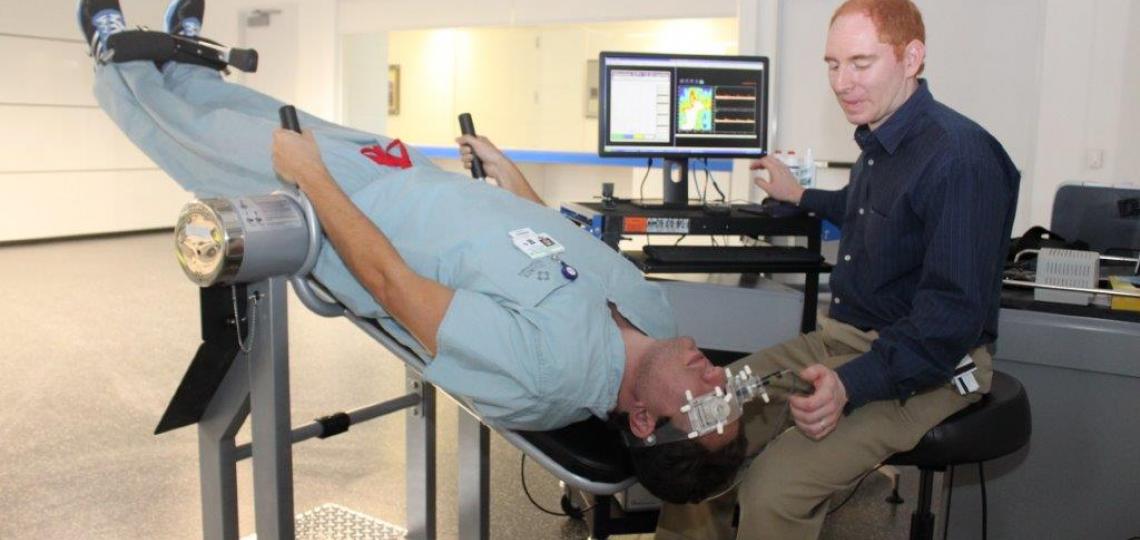Featured Projects
The Center for Space Medicine offers research training opportunities to Baylor College of Medicine students, residents and fellows. Research projects (complete and ongoing) are conducted in collaboration with many Baylor departments, including neurology, obstetrics and gynecology, ophthalmology, pediatrics, anesthesiology and medicine.
Featured projects include the following.

Vittamed Two Depth Transcranial Doppler for Intracranial Pressure Assessment in the Astronauts Before and After Spaceflight
Eric M. Bershad, M.D., Leslie Malkin-Gosdin, Eusebia Calvillo, R.N., Jose I Suarez, M.D., Chethan Venkatasubba Rao, M.D. Nelson Maldonado, M.D., Rahul Damani, M.D., Aashish Anand, M.D., Steve R.. Dunham, M.D., Rod Foroozan, M.D., and Stacia M. DeSantis, Ph.D.
Astronauts have developed ocular changes affecting vision in microgravity, associated with findings suggestive of elevated intracranial pressure (ICP). Currently, the ICP can only be measured by placing an invasive catheter through the skull, or a spinal needle in the lower back. The methods carry small but potentially serious adverse effects; therefore it is desirable to develop a non-invasive technology for measuring the ICP.
The research team is evaluating a novel transcranial Doppler based device that compares the blood flow in two different segments of the ophthalmic (eye) artery (OA). At baseline, an imbalance exists between the blood flow characteristics between the intracranial and extracranial segments of the OA due to a transmural effect of ICP on the OA wall in the intracranial but not the extracranial segment. The device attempts to find the balance point by adding incremental pressure on the orbit to equalize the blood flow characteristics between the two OA segments. The ICP is estimated by the amount of external orbital pressure required to balance the two OA segments. Phase 1 of the study will determine the operator learning curve, repeatability, reproducibility, inter-eye agreement, and effect of head-down tilt on non-invasive measurements in healthy subjects. Phase 2 will determine the accuracy of the non-invasive ICP measurement compared to simultaneous invasive measurement with lumbar puncture in patients.
Integration of Physiologic Monitoring Systems for Aerospace Applications
Alex Garbino, Ph.D., Jonathan Clark, M.D., M.P.H.
Remote monitoring of physiological parameters facilitates rapid intervention when problems arise, whether during extravehicular activity in space or in a hospital or home on Earth. The project looked at commercially available, portable medical sensor packages for durability, measurement technique, weight, volume, cost and accuracy. Oximetry, electrocardiography and chest excursion monitors were evaluated for their portability as well as real-time transmission of data. The medical devices were integrated into astronaut pressure suits and tested in a field environment. Technological advances in remote monitoring equipment made compact and easy-to-use in human spaceflight may also have the potential to offer new telemedicine solutions on Earth.
Risk Factors Impacting Intracranial Pressure in Long-Duration Astronauts
Derek Nusbaum, M.D., R. Blaine Easley, M.D., Kathy Kibler, B.S., Ken Brady, M.D., Samuel Wu, Ph.D., Jonathan Clark, M.D., M.P.H., Jeffrey Sutton, M.D., Ph.D.
During long-duration spaceflight, a significant percentage of crew members have exhibited serious visual impairments and a concomitant increase in intracranial pressure. Because the etiology is unknown, this study will investigate the contribution of possible spaceflight-associated risk factors such as increased CO2 and cephalad venous fluid shifts. This work will look at the effects of increases in these variables on intracranial pressure. The findings will impact our understanding of underlying pathophysiology in astronauts and may also contribute to the development of mitigation strategies for patients suffering from idiopathic intracranial hypertension here on earth.
Effect of Body Position on Olfactory Sense in Patients with Idiopathic Intracranial Hypertension
Eric M. Bershad, M.D., Zain Urfy, M.D., Denise Chen, Ph.D.
Astronauts have reported nasal congestion and impaired taste sensation in microgravity. Because taste depends mainly on olfactory function (smell), it is likely that the olfactory sense is impaired in microgravity. Impaired olfactory function may be the result of a pathological increase in intracranial pressure, as seen in various neurological conditions on Earth.
The research team is testing the effect of body position on the olfactory sense in patients with chronic, elevated intracranial pressure and control subjects. It is expected that there will be an impairment in olfactory sense in the negative six-degree head-down tilt position, compared to upright, due to venous congestion in the head and subsequent cerebrospinal fluid diversion along the olfactory pathways resulting in transient olfactory bulb dysfunction.
Development and Optimization of an Intracranial Pressure Measurement and Infusion System in the Mouse
Chadwick Richard, MS4, Benjamin Frankfort, M.D., Ph.D., Samuel Wu, Ph.D., Derek Nusbaum, M.D.
During long-duration space?ight, a signi?cant percentage of crew members have exhibited serious visual impairments and a concomitant increase in intracranial pressure. Because the etiology is unknown, this study investigates the contribution of possible spaceflight-associated risk factors such as increased CO2 and cephalad venous fluid shifts. This project uses an animal model to look at the effect of increases in these variables on intracranial pressure.
Adnexal Torsion in Space
Elliott Richards, MS4., Jennifer Dietrich, M.D.
Since Valentina Tereshkova’s legendary voyage on Vostok 6 in 1963, fifty-six women have flown to space. Adnexal torsion, which is the twisting of the ovary and/or the fallopian tube on its support pedicle, has been briefly referenced in the space medicine literature (Law 2011, Barratt 2008). This project reviews the research findings and treatment guidelines of adnexal torsion in the context of the limitations inherent in a space environment.
Cerebral Oxygenation at High Altitude
Sean Bradley, MS4, Jeffrey P. Sutton, M.D., Ph.D., Gary Strangman, Ph.D., Quan Zhang, Ph.D.
NINscan is a small, lightweight, portable device for non-invasive monitoring of cerebral blood oxygenation. This device was used to assess a decrease in oxygenation associated with ascent to an elevation of 14,000 feet. NINscan holds promise for monitoring brain function in harsh remote environments, including space.








